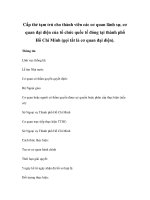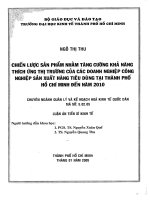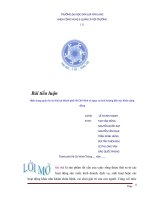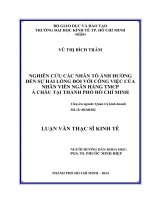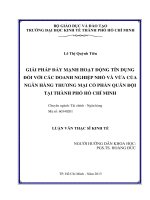Niềm tin của giáo viên và sinh viên về tương tác trong lớp học ở các lớp tiếng anh không chuyên có sĩ số đông tại thành phố hồ chí minh
Bạn đang xem bản rút gọn của tài liệu. Xem và tải ngay bản đầy đủ của tài liệu tại đây (1 MB, 236 trang )
STATEMENT OF AUTHORSHIP
I certify my authorship of the PhD thesis submitted today entitled:
“Teachers’ and Students’ beliefs about classroom interactions in large nonEnglish majored classes in Ho Chi Minh city”
for the degree of Doctor of Education, is the result of my own research, except where
otherwise acknowledged, and that this thesis has not been submitted for a higher
degree at any other institutions. To the best of my knowledge, the thesis contains no
material previously published or written by other people except where the reference is
made in the thesis itself.
Hue, October 5th, 2018
Author’s signature
Trần Thị Thanh Thương
i
ACKNOWLEDGEMENTS
I would like to express my sincere gratitude to my academic supervisor, Assoc.
Prof. Dr. Le Pham Hoai Huong, for her early suggestion of the topic, significantly
important suggestions on the analysis of the data and conscientious guidance and
supervision throughout the writing of this thesis.
I am indebted to the lecturers of Hue University of Foreign Languages: Assoc.
Prof. Dr. Trần Văn Phước, Assoc. Prof. Dr. Phạm Thị Hồng Nhung, Assoc. Prof. Dr.
Trương Viên, Dr. Tôn Nữ Như Hương, Dr. Trương Bạch Lê, Dr. Phạm Hoà Hiệp who
have wholeheartedly guided me through each part of the thesis. I own a word of thanks
to Assoc. Prof. Dr. Lê Văn Canh for giving me suggestions with my early development
of the thesis topic. I am thankful to Ms. Hồ Thị Phùng Duyên, MA, Dean of the
Foreign Languages Department and my colleagues at HCM College of Foreign
Economic Relations for supporting me and taking up my workload while I was doing
my study. I also would like to express my thanks to the Admnistration Board of my
college for granting me study leave. I am grateful to the lecturers of HCM University
of Law, HCM University of Environment and HCM University of Industry and
students of these universities for their participation into the study and for allowing me
to record their classes. I thank the participants for filling the questionnaires and
answering the interviews. I am also thankful to my former colleague and friend, Trần
Thi Thu Trang for helping me with reference materials used in the thesis.
My special appreciation goes to my husband, Dũng, and my daughters, Ngọc and
Thi, for their support and love. My husband has been the most patient and supportive
partner who in many ways put his own ambitions aside so that I could accomplish
mine.
ii
Last but not least, I owe a special word of thanks to my parents, parents-in-law and
all other members in my family, who have always given me encouraging words as well
as financial and spiritual support.
iii
TABLE OF CONTENTS
STATEMENT OF AUTHORSHIP .................................................................................. i
ACKNOWLEDGEMENTS .............................................................................................. ii
LIST OF ABBREVIATIONS........................................................................................ viii
LIST OF TABLES ........................................................................................................... ix
ABSTRACT
.................................................................................................................. x
CHAPTER 1: INTRODUCTION ................................................................................. 1
1.1
Rationale ............................................................................................................ 1
1.2
Research Aims................................................................................................... 3
1.3
Research Questions........................................................................................... 4
1.4
Research Scope ................................................................................................. 4
1.5
Research Significance ....................................................................................... 5
1.6
Structure of the Thesis ..................................................................................... 6
CHAPTER 2: LITERATURE REVIEW ..................................................................... 7
2.1
Introduction ...................................................................................................... 7
2.2
Definitions of Interaction ................................................................................. 7
2.3
Teachers’ and Students’ beliefs ....................................................................... 8
2.4
Classroom Interactions .................................................................................. 10
2.5
Major Features of Classroom Interactions .................................................. 13
2.5.1.
Classroom Interactional Competence ....................................................... 15
2.5.2.
The First Language in Classroom Interactions ........................................ 15
2.6
Approaches to Classroom Interactions ........................................................ 16
2.6.1.
Interactionism/Interactionist Theory ........................................................ 16
2.6.2.
Sociocutural Theory .................................................................................... 18
2.7 Similarities and Differences between Interactionism/interactionist theory
and Sociocultural Theory in terms of Classroom Interactions ............................ 20
iv
2.8
Teacher-learner Interaction .......................................................................... 22
2.9
Learner-learner Interaction .......................................................................... 24
2.10
Interactions in Large Classes ..................................................................... 25
2.11
Operational Definitions of Classroom Interactions in the Current Study28
2.12
Non-English Majored Students and ESP Teachers in Vietnam ............. 28
2.12.1.
Non-English Majors ................................................................................. 28
2.12.2.
ESP Teachers............................................................................................ 29
2.13
Previous Studies........................................................................................... 30
2.13.1.
In Vietnam ................................................................................................ 30
2.13.2.
In other countries ..................................................................................... 32
2.14
Summary ...................................................................................................... 36
CHAPTER 3: RESEARCH METHODOLOGY ....................................................... 37
3.1
Introduction .................................................................................................... 37
3.2
Research Design .............................................................................................. 37
3.3
Research Participants..................................................................................... 39
3.3.1.
Teacher Participants ................................................................................... 39
3.3.2.
Student Participants.................................................................................... 40
3.4
Data Collection Methods ................................................................................ 41
3.4.1.
Questionnaires ............................................................................................. 42
3.4.1.1.
Questionnaire for students ...................................................................... 44
3.4.1.2.
Questionnaire for Teachers .................................................................... 45
3.4.2.
Interviews ..................................................................................................... 45
3.4.3.
Observation with Audio-recording of Classroom Interactions .............. 48
3.5
Research Procedure ........................................................................................ 49
3.5.1.
Pilot study..................................................................................................... 49
3.5.2.
Main study ................................................................................................... 50
3.6
Research Methods on Classroom Interactions ............................................ 51
3.7
Data Analysis................................................................................................... 52
v
3.8
Research Reliability and Validity ................................................................. 53
3.9
Ethical Considerations ................................................................................... 56
3.10
Summary ...................................................................................................... 56
CHAPTER 4: FINDINGS AND DISCUSSION ......................................................... 57
4.1
Introduction .................................................................................................... 57
4.2
Findings ........................................................................................................... 57
4.2.1. Teachers’ and Students’ beliefs about Class Size and Classroom
Interactions ................................................................................................................ 58
4.2.2. Teachers’ and Students’ beliefs about the Roles of Teachers in
Classroom Interactions in Large Classes ............................................................... 63
4.2.3. Teachers’ and Students’ beliefs about the Roles of Students in
Interactions in Large Classes ................................................................................... 78
4.2.4. Teachers’ and Students’ beliefs about the Roles of the Target Language
in Classroom Interactions ........................................................................................ 88
4.2.5. Teachers’ and Students’ beliefs about the Roles of the First Language in
Classroom Interactions .......................................................................................... 102
4.3
Discussion on Data from Questionnaires and Interviews ......................... 108
4.3.1. Similarities in Teachers’ and Students’ beliefs about Classroom
Interactions in Large Non-English Majored Classes .......................................... 108
4.3.2. Differences in Teachers’ and Students’ beliefs about Classroom
Interactions in Large Non-English Majored Classes .......................................... 111
4.4
Discussion on Data from Audio Recordings of Classroom Interactions . 113
4.5
Summary ....................................................................................................... 118
CHAPTER 5: CONCLUSION, IMPLICATIONS, LIMITATIONS, AND
RECOMMENDATIONS FOR FURTHER STUDY ................................................. 119
5.1
Summary of the Key Findings ..................................................................... 119
5.2
Implications ................................................................................................... 122
5.3
Limitations .................................................................................................... 124
5.4
Suggestions for further study ...................................................................... 125
vi
5.5
Conclusion ..................................................................................................... 125
REFERENCES .............................................................................................................. 129
AUTHOR’S WORKS ................................................................................................... 147
APPENDICES .............................................................................................................. 148
APPENDIX H
MINIMUM-MAXIMUM .......................................................... 220
Class Size and Classroom Interactions ................................................................. 220
APPENDIX I
MINIMUM-MAXIMUM......................................................... 221
Roles of Teachers in Classroom Interactions in Large Classes .......................... 221
APPENDIX J
MINIMUM-MAXIMUM ........................................................... 222
Roles of Students in Interactions in Large Classes .............................................. 222
APPENDIX K
MINIMUM-MAXIMUM .......................................................... 224
Roles of the Target Language in Classroom Interactions................................... 224
APPENDIX L
MINIMUM-MAXIMUM .......................................................... 225
Roles of the First Language in Classroom Interactions ...................................... 225
vii
LIST OF ABBREVIATIONS
EFL:
English as a Foreign Language
ESP:
English for Specific Purposes
IRE:
Information, Response, Evaluation
L1 :
First Language
L2:
Second Language
M:
Mean
SLA:
Second Language Acquisition
SCT:
Sociocultural Theory
SPSS:
Statistical Package for the Social Sciences
viii
LIST OF TABLES
Table 3.1 Teacher Participants
Table 3.2 Student Participants
Table 3.3 Summary of Data Collection Methods
Table 3.4 Summary of the Questionnaire Clusters
Table 3.5 Cronbach's Alpha Reliability Analysis of Clusters of Teachers' and
Students’ responses
Table 4.1 Mean Scores of All Questionnaire Clusters
Table 4.2 Teachers' and Students’ beliefs about Class Size and
Classroom Interactions
Table 4.3 Teachers' and Students’ beliefs about the Roles of
Teachers in Interactions in Large Non-English Majored Classes
Table 4.4 Teachers' and Students’ beliefs about the Roles of Students in
Interactions in Large Non-English Majored classes
Table 4.5 Teachers' and Students’ beliefs of the Roles of the Target
Language in Large Non-English Majored Classes
Table 4.6 Teachers' and Students’ beliefs about the Roles of the Mother
Tongue in Large Non-English Majored Classes
ix
ABSTRACT
This study was conducted at some universities in Ho Chi Minh city in Vietnam.
The objectives aimed at finding out the similarities and differences in teachers’ and
students’ beliefs about classroom interactions in large non-English majored classes and
how teachers’ and students’ beliefs about classroom interactions corresponded to their
actual practice. Data were collected from questionnaires for 100 teachers teaching
English to non-English majors and 100 students. Besides, semi-structured interviews
were conducted with representative teachers and students from both groups.
Additionally, audio-recordings of 45 lesson periods were used to verify the actual
practice of classroom interactions in large non-English majored classes.
The findings reveal that both teachers and students believed that classroom
interactions involved talks between teachers and students, and among students.
Furthermore, teachers and students similarly considered that classroom interactions in
large non-English majored classes were restricted because students did not have a lot of
opportunities for speaking. The two groups also agreed that teachers should talk less to
give opportunities for students to speak. As or language use, both groups tended to
think that language is used to provoke thoughts and that students can use the first
language when necessary to mediate the thinking process of learning English.
However, teachers’ responses achieved higher mean scores on the opinion that students
can learn from other peers through interactions. Also, more teachers thought that peer
interactions mediate students’ thinking process and that peer interaction provides
language input for students.
The audio recordings of classroom reflect teachers’ beliefs of the dominant roles of
teachers in managing classroom interactions. Their turns usually included three-part
sequential IRE (Information, Response, Evaluation). Additionally, the transcripts
confirm teachers’ and students’ belief that in large classes, pair work and group work
x
were employed to provide speaking opportunities for students. In excerpts of
interactions where only peers participated, the interactions indicate more equal roles of
peers in co-constructing knowledge. Despite the fact both teachers and students highly
appreciated the opportunities for students to use English in the class, the audio
recordings revealed the frequent use of Vietnamese by teachers to facilitate students in
completing the given tasks.
xi
CHAPTER 1:
INTRODUCTION
1.1 Rationale
Researching teachers and students’ beliefs in education is without doubt
essential. “It is perfectly legitimate to be interested in the ways in which 'knowledge
workers' in general carry out their work, or think and talk about their work” (Havita
& Goodyear, 2001, p.2). Beliefs about teaching and learning, more specifically,
about classroom interactions, can bring about the opportunities for educational
change. Studies on the thought processes involved in teaching and learning can give
teachers and learners a more realistic view of how interactions in classroom take
place.
Promoting classroom interactions has always been the target of the English
language education. The reason comes from the fact that they can facilitate
language communication in the classroom which may lead the development of
language competence. Interactionism or Interaction Hypothesis (Long, 1996) has
been embraced in many second/foreign language researches for it emphasizes that
language
development
is
facilitated
through
face-to-face
interaction
or
communication. Besides, it is worth investigating classroom interactions because
they serve several important functions including referential function of
communicating curriculum content, social function of maintaining and establishing
social relationships between teachers and students, and ideational function of
helping teachers and students negotiate and express their ideas through discourse
(Cazden, 1988). Similarly, Walsh (2011, p.158) regards classroom interaction as a
central tool to facilitate, mediate and assist learning.
As classroom interactions play essential roles in language teaching and
learning, studying teachers’ and students’ beliefs on this topic apparently may shed
more light on what leads to how they interact with each other. Additionally,
understanding teachers’ and students’ opinions will help promote effective practice
in classroom interactions. Results of such investigation will also assist teachers and
1
students to set more realistic goals in designing activities or adopting classroom
management strategies that promote classroom interactions.
Studying teachers’ and students’ beliefs about interactions in large classes, to
some extent, dwells on some aspects that are rather different from interactions in
other classes for several reasons. Firstly, large classes consist of a range of abilities
as well as diverse student learning styles (Cleek, 2005). Secondly, students can feel
anonymous and voiceless and teachers in large classes often feel compelled to focus
on content delivery; therefore, interactions in large classes may become even more
challenging (Hall, Binney & Kennedy, 2005). Lastly, discipline in a large class is
another matter in large classes due to a large number of students, teachers might not
be able to manage to engage all students into interactions (Vrasidas & McIsaac,
1999).
In Vietnam, English holds an important role in the foreign language policy. The
Ministry of Education and Training in Vietnam issued Circular 7274/BGDĐTGDĐH dated 31/10/2012 describing the National Foreign Languages Project 2020
for educational institutions. MOET also issued the framework of six-level foreign
language competence for Vietnam in Circular 01/2014/TT-10 BGDĐT dated
24/01/2014. The circular states that non-language majored university students must
reach the level of 3 (B1) in foreign language competence and junior college students
at level 2 (A2). These prescriptions indicate the urgent need for teachers and
students to work effectively in their English teaching and learning to reach the
target. Clearly, in most university and junior college students in Ho Chi Minh city,
students need to achieve the level of B1 or A2 in English Proficiency to be able to
graduate. For example, at the College of Foreign Economic Relations, Ho Chi Minh
city, Vietnam, students are expected to be able to communicate in English and use
English for their majors to serve their jobs ( />/311/news/2046-chuan-dau-ra-bac-cao-dang-cho-cac-nganh-dao-tao.aspx).
2
In recent years, sociocultural theory stressing the interaction between people
and the culture in which they live has been well used in educational research
(Lantolf, 2000). Its significance in serving as a conceptual framework has proved to
be appreciated for its relevance in providing interpretations. The theory applied in
classroom research suggests that human learning is largely a social process through
classroom interactions.
As an English lecturer at a college in Ho Chi Minh city for more than a decade,
I myself have been intrigued to the question of what factors can promote classroom
interactions. My experience in teaching large ESP classes has revealed to me that
teachers and students have different beliefs about classroom interactions. As
students of different majors learn English as a compulsory subject, their attitudes
toward this subject are diverse. I have been searching for the answer to the question
what teachers and students think about classroom interactions and how they actually
carry out classroom interactions.
For the reasons above, the current study was set out to investigate the topic of
interactions in large classes for non-English majored students.
1.2 Research Aims
The current study aims to
-
Explore teachers’ and students’ beliefs about classroom interactions, more
specifically, to understand why they interact in certain ways in the
classroom, what they believe and think about classroom interactions.
-
Compare the beliefs of teachers and students about classroom interactions to
find out some similarities and differences to help both teachers and students
set more realistic goals in maintaining classroom interactions.
-
Explore whether teachers’ and students’ beliefs about classroom interactions
correspond to their actual practice of classroom interactions.
3
-
Suggest some solutions for promoting effective classroom interactions.
-
Develop an understanding of classroom interactions and improve classroom
interaction management.
1.3 Research Questions
This study tried to answer the following research questions:
What are teachers' beliefs about the roles of classroom interactions to students’
learning in non-English majored large classes?
What are students' beliefs about the roles of classroom interactions to their
learning in non-English majored large classes?
What are similarities and differences between teachers’ and students’ beliefs
about the roles of classroom interactions in non-English majored large classes?
How do teachers’ and students’ beliefs about the roles of classroom interactions
correspond to their actual practice?
1.4 Research Scope
Research on teachers and students’ cognition of classroom interactions is a
broad field. The current study examined their beliefs on the roles of language
interactions in classroom only. More specifically, it focused on exploring the verbal
interactions taking place in a structured manner of planned lessons with the aid of
textbooks. Non-verbal interaction was not explored due to the scope limitation of
the current study. Besides, nonverbal behaviors are considered to vary markedly in
their acceptability from culture to culture (Klopf, 1998). In this study, all the
participant students came from the same Vietnamese culture and their nonverbal
behaviors are not expected to vary culturally. Furthermore, it is beyond the scope of
the study to explore the non-linguistic features of talk by teachers and students.
4
The title of thesis contains the phrases “non-English majored classes” and
“large classes”; however, these terms refer to the research site and contexts for
participant selection and data collection. They were not set out as variables for
measurement or calculation of data. Similarly, Ho Chi Minh city refers to the
research site where three universities were chosen for data collection for the current
study.
1.5 Research Significance
Theoretically, this study hopes to contribute to the literature on teacher
cognition, classroom interactions, how interactionism and sociocultural theory can
be used to explain and interpret beliefs about classroom interactions and actual
patterns of classroom interactions. It is significant to investigate teacher cognition
because it has become a key theme in the field of language teaching and teacher
education (Borg, 2015). Besides, “Cognition not only shapes what teachers do but
also is in turn shaped by the experiences teachers accumulate” (Borg, 2003, p. 95).
More specifically, the study hopes to shed light how what constitutes teachers’
thinking in conducting interactions in the classroom and why they believe so.
Understanding teachers’ belief is important to explore the linkages between the
teaching mind and practice.
Pedagogically, the study findings can provide implications for teachers and
students in managing and promoting effective classroom interactions, especially in
large classes for non-English majored students. In a word, understanding beliefs is
important in the ELT context. It is even more necessary to find out teachers’ and
students’ beliefs about classroom interactions as they may provide some indications
of how teachers and students behave in their actual classroom interactions as
Nguyễn Thanh Nga (2014, p. 43) stated, “Teachers’ beliefs influence instructional
behaviours and actual teaching practices”.
5
1.6 Structure of the Thesis
This thesis contains five chapters. Chapter one provides the rationale for the
current study and states the research objectives, questions, scope and significance.
Chapter two reviews the literature related to classroom interactions, and justifies the
conceptual framework for the current study. It also presents previous studies and
gaps in the literature. Chapter three describes the research methodology. Chapter
four displays the findings and discusses the findings in the light of the literature.
Finally, chapter five summarizes the key findings of the study, provides
implications and discusses the contributions of the current study.
6
CHAPTER 2:
LITERATURE REVIEW
2.1 Introduction
This chapter presents a review of different approaches to classroom
interactions. It first synthezises different definitions of classroom interactions,
features of classroom interactions and then analyses the two main approaches to
classroom interactions, namely, interactionism and sociocultural theory. Besides, it
discusses interactions in large classes as well as in non-English majored classes.
The chapter also documents previous studies related to the current one and points
out the gaps in the literature.
2.2 Definitions of Interaction
Quite a number of definitions have been put forward for the term of
interactions; however, interactions have not been clearly or operationally defined
(Wagner, 1994). The exact meaning of the term has varied across studies (Battalio,
2007). With a large number of factors that contribute to interaction, it has become
difficult to reach an agreement on exactly what constitutes interaction (Soo & Bonk,
1998).
Vrasidas and McIsaac (1999, p. 25) point out that interaction is “the process
consisting of the reciprocal actions of two or more actors within a given context”.
Wagner (1994, p. 8) defined interaction within the context of learner performance:
An instructional interaction is an event that takes place between a learner and
the learner’s environment. Its purpose is to respond to the learner in a way intended
to change his or her behavior toward an educational goal. Interaction is an important
word for language teachers and language learning. Brown (1994) said that in the era
of communicative language teaching, interaction is the heart of communication.
Similarly, Rivers (1987) stated that through interaction, students can increase their
language assimilation as they listen and read ‘authentic linguistic materials’, or even
the output of their fellow students in discussions, joint problem-solving tasks, or
7
dialogue journals. In the process of interaction, students can produce what they have
learned or absorbed in real life exchanges. It could be said that interaction is the
collaborative exchange of thoughts, feelings or ideas between two or more people
resulting in a reciprocal effect on each other.
2.3 Teachers’ and Students’ beliefs
Research on teacher’s belief is part of the inquiry of teacher cognition.
According to Borg (2015), teacher cognition is what teachers think, know and
believe and its relationship to teachers' classroom practices. Understanding
language teachers’ cognition is to explore teachers’ mental lives. This is important
because their mental lives form and are shaped by the practice of language teaching
in different contexts (Kubanyiova & Feryok, 2015).
Clearly, belief is part of cognition and there are different ways to define belief.
Beliefs are central constructs in every discipline which deals with human behaviour
and learning (Sakui & Gaies 1999, p. 474). Beliefs are synonymous with attitudes,
representations, opinions or ideologies (Fraser & Gaskell, 1990).
According to Borg (2001, p.186):
A belief is a proposition which may be consciously or unconsciously held, is
evaluative in that it is accepted as true by the individual, and is therefore
imbued with emotive commitment; further, it serves as a guide to thought
and behavior.
According to Schwitzgebel (2006), belief is a way of defining a mental
representation of an attitude positively oriented towards the likelihood of something
being true. Wikipedia defines belief as the state of mind in which a person thinks
something to be the case, with or without there being empirical evidence to prove
that
something
is
the
case
with
factual
certainty
( Similarly, Oxford dictionary defines “belief”
as a firmly held opinion or conviction or an acceptance that a statement is true or
8
that something exists. Lê Văn Canh (2011, p. 51) considered the term “teachers’
beliefs” to be a generic term referring to the “statements teachers make about their
ideas, thoughts and knowledge that are expressed as evaluations of what “should be
done” “should be the case” and “is preferable”.
Comparing belief with knowledge, Pajares (1992, p. 313) pointed out, “Belief is
based on evaluation and judgment; knowledge is based on objective fact”. Beliefs
are more personal and subjective than knowledge and clearly a person’s beliefs
affect the way his/her knowledge can be used (Nespor, 1987). Thus, different
teachers may have similar knowledge about teaching or learning methods, but they
will teach and learn in different ways because of personal beliefs on their decision
making (Ernest, 1989).
In the educational context, teachers’ beliefs are closely connected with
educational practices. More specifically, “teachers’ pedagogic beliefs or those
beliefs of relevance to an individual’s teaching” (Borg, 2001, p. 187). Similarly,
Nguyễn Thanh Nga (2014, p.40) stated, “All teachers hold beliefs about their
profession, themselves as professionals and matters beyond their profession.”
Despite the fact that teachers’ beliefs mainly focus on teaching practices, it is still a
broad term which may indicate teacher efficacy, the nature of language, teachers’ or
students’ performance, motivation, or other topics related to ELT. The current
research focuses on teachers’ beliefs about classroom interactions.
According to Atkinson, Nishino, Churchill, and Okada (2007), it is important to
understand different factors that may shape the way people think and behave,
especially in the teaching contexts. These authors point out that from the
sociocognitive perspective, there are complex processes through which human
beings are influenced by coordinated interaction, both with other human beings and
environments, situations, tools, and affordances. In other words, for investigation of
beliefs, factors that affect beliefs should be taken into consideration.
9
“Learner beliefs are generally what learners bring into the classroom learning
environment which may be based on their cultural background or even their
learning experience” (Nhapulo, 2013, p. 84). In the classroom context, the beliefs
that students bring with them to the learning situation have been recognized as a
significant contributory factor in the learning process and ultimate success (Breen,
2001). Some beliefs held by second or foreign language students include the nature
of the language learning, the process of its acquisition, the success of certain
learning strategies, the existence of aptitude, etc. In this study, beliefs are opinions
of teachers and students related to their thinking and attitudes towards classroom
interactions.
Burns, Freeman and Edwards (2015), however, used the term of language
teaching mind to refer to teacher cognition in language education research.
According to these authors, research starts with teachers’ thinking and what they do
will help to identify ecologies of practice because there are linkages between
cognition and language teaching.
Clearly, there are different definitions of belief but they share some features in
common which are the notion of personal opinion and attitude towards an issue.
This is also the definition used in the current study.
2.4 Classroom Interactions
Classroom interactions occur everyday in the classroom activities between the
teacher and the learners and among learners. In language classrooms, interactions
play an especially significant role to serve as the medium through which learning is
realized and an object of pedagogical attention. Classroom interactions can lead to
learning (Barnes, 1992; Cazden, 1988; Mehan, 1979).
Another aspect of classroom interactions is student to student interaction which
can determine students’ success in learning (Tinto, 1999). Students can feel a
connection with their peer group. Besides, students can echo one another in the
10
process of interaction. Drawing on Halliday’s (1975) theory of language, Sinclair
and Coulthard (1975) described what they found to be the basic unit of classroom
interaction, a three-part sequential IRE (Information, Response, Evaluation)
exchange. According to these authors, IRE involves the teacher, in the role of
expert, eliciting information (I) from individual students in order to ascertain
whether each knows the material. The teacher does this by asking a known-answer
question to which the student is expected to provide a brief response (R). The
teacher then evaluates the student’s response (E) with such typical phrases as
“Good,” “That’s right”, or “No, that’s not right.” IRE has been seen in classroom
interactions studies ranging from all ages and contexts (e.g., Barnes, 1992; Cazden,
1988; Green & Dixon, 1993; Gutierrez, 1994; Mehan, 1979; Nystrand, Gamoran,
Kachur, & Pendergast, 1997; Smagorinsky & Fly, 1993). There are connections
between the IRE pattern of language use and language development. The study by
Cazden (1988), for example, revealed that the use of the IRE often facilitated
teacher control of the interaction rather than student learning of the content of the
lesson. Similarly, Barnes (1992) found that the frequent use of the IRE pattern of
interaction did not allow for complex ways of communicating between the teacher
and students. Rather, it was the teacher who decided who would participate, when
students could take a turn, and how much they could contribute.
To some researchers, classroom interactions include both verbal and
nonverbal channels. Hall and Sandler (1984) suggested that nonverbal behavior,
such as eye-contact, leaning forward, nodding to show attentiveness, and refraining
from touching and invading the space of the students have an impact on
intercultural communication. These nonverbal behaviors vary markedly in their
acceptability from culture to culture (Klopf, 1998). This study, however, only
focused on verbal interactions by both teachers and students due to the scope
restriction. As mentioned earlier, all the participant students came from the same
Vietnamese culture and their nonverbal behaviors are not expected to vary
culturally.
11
Apparently, interactions are very important in the classroom because they
provide the opportunity for sharing perspectives, receiving feedback, and bringing
about knowledge (Garrison & Shale, 1990). With the appearance of the Internet,
interactions now change the way teachers and students interact online. According to
York, Yang, and Dark (2007, p. 41), interaction is one of the primary goals of
online education because it is connected to learning and the motivation to learn.
Regardless of the setting of traditional classroom or an online program, interaction
is a key factor in effective learning. The study by Cao, Crews, Lin, Burgoon, and
Nunamake (2008, p. 53) found that interaction with instructors and other students,
either face-to-face or through an electronic medium, is a consistent and reliable
predictor of positive learning outcomes even for distance education programs.
Students interact with instructors to look for prompt feedback, guidance, and
motivational and emotional support. Chaudron (1988, p.10) stated that interaction is
viewed as significant because it is argued that only through interaction, the learner
can decompose the teaching learning structures and derive meaning from classroom
events. Moreover, Allwright and Bailey (1996, p. 25) said that through classroom
interaction, students produce outcomes (input, practice opportunities, and
receptivity).
It is undeniable that interactions in classroom are vital to the learning process.
However, Hutchinson (2007, p. 364) cautions that a large number of ideas raised at
one time in interaction may actually hinder motivation. Morever, when students do
not receive attention or feedback, they may lose motivation. In the process of
interactions, some students may be apprehensive about how other learners may
view and criticize their ideas. To maintain motivation for learners requires
instructors to have a healthy support structure in place, develop a good rapport with
the learners, and provide feedback to each of the learners.
12
2.5 Major Features of Classroom Interactions
Interactions may vary in different classrooms and cultures. However, they share
some key features. Walsh (2011) reviewed them as: Control of the interaction,
speech modification, elicitation techniques, and repair or Initiation, Response,
Feedback (IRF) exchange structure. As the roles of teachers and learners are
asymmetrical, teachers usually seem to have the control of the patterns of
communication that occur by managing both the topic of conversation and turntaking. With speech modification, teachers usually want to ensure that the class is
following, that everyone understands and that learners do not “get lost” in the rapid
flow of the discourse. As a result, they modify their language use by simplifying
and elaborating their speech. Apart from control of the interaction and speech
modification, Walsh (2011) pointed out that teachers often use elicitating techniques
to prompt a response, check understanding, guide learners towards a particular
response, promote involvement and check concept understanding in classroom
interactions. The concept of repair refers to the ways in which teachers deal with
errors. It includes direct and indirect error correction and the ways in which teachers
identify errors in the discourse. Lastly, IRF exchange deals with a teacher Initiation,
a student Response, and a teacher Feedback. The technique indicates that most of
the time, teachers’ feedback is an evaluation of a student’s contribution. Teachers
are constantly assessing the correctness of an utterance and giving feedback to
learners.
The IRF structure was originally developed by Sinclair and Coulthard (1975)
from research concerning the structural description of discourse found in the
classroom. It has evolved in research on classroom interactions focusing on
classroom discourse. Wells (1993) however pointed out that the IRF structure can
be seen to aptly characterize the teacher’s major responsibilities. Cazden (1988),
however, criticized that the use of the IRF often facilitated teacher control of the
interaction rather than student learning of the content of the lesson. Thus, it limits
13
students’ opportunities to talk through their understandings and try out their ideas in
relation to the task.
From the perspective of sociocultural theory, Mercer (2004) argued that
classroom discourse can be analyzed based on the Vygotskian conception of
language as both a cultural and a psychological tool. The analysis involves a
combination of qualitative and quantitative methods and enables the study of both
educational processes and learning outcomes. On the one hand, for qualitative
features of interactions, students use language as a tool for collective thinking to
create more shared understanding and to inter-think. This collective thinking looks
at the general social climate of ideas associated with a topic rather than specific
conversations. It focuses more on the function of interaction for the pursuit of joint
intellectual activity. “It incorporates a concern with the lexical content and the
cohesive structure of talk, especially across the contributions of individual speakers,
because word choices and cohesive patterning can represent ways that knowledge is
being jointly constructed” (Mercer, 2004, p. 141). On the other hand, quantitative
analysis incorporates a concern with the lexical content and the cohesive structure
of talk, especially across the contributions of individual speakers. More specifically,
it looks at word choices and cohesive patterning that represent ways that knowledge
is being jointly constructed. In general, sociocultural discourse analysis (Mercer,
2004) examines the relationship between particular interactions which occur at
different times and quantitative assessing the relative incidence of key words or
collocations of words in the data as a whole, or comparing their incidence in data
subsets.
Lê Phạm Hoài Hương (2007) argued that features of classroom interactions
should take into account the roles of peers and how peers interact to reach the
common goal of the talk. Classoom interactions features include collective
scaffolding in which peers scaffold each other with questions, ideas, vocabulary to
complete the given tasks. More knowledgeable peers can assist other peers in
managing the tasks as well as create more opportunities for them to use the target
14

